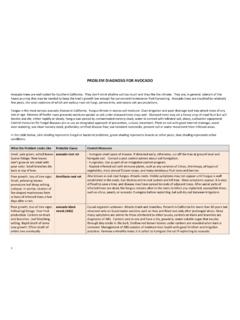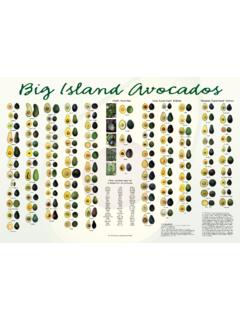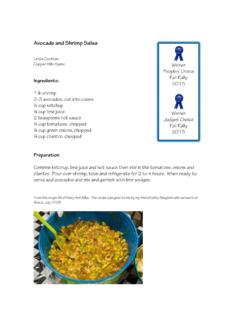Transcription of AVOCADO - Food and Agriculture Organization
1 AVOCADOPost-harvest Operations - Post-harvest CompendiumAVOCADO: Post-Harvest Operation Organisation: Food and Agriculture Organization of the United Nations, FAO, Rome, Italy Author: Lidia Dorantes, PhD., Lidia Parada, MSc., Alicia Ortiz, PhD. Edited by AGST/FAO: Danilo Mej a, PhD, FAO (Technical) Last reviewed: 15/06/2004 Contents 1 1 Introduction .. 3 Economic and Social Impact .. 9 World Trade .. 11 Primary Product (fresh).. 14 Secondary product (processed) .. 16 Elements on quality assurance and export marketing .. 18 Consumer preferences .. 23 2 Post- Production Operations .. 25 Harvesting .. 25 Packinghouse operations .. 28 Packing and packaging materials .. 30 Cooling 32 Storage of AVOCADO .. 33 Transportation systems .. 34 Processing .. 35 3. Pest control and decay.
2 37 Pest species .. 37 Relative status of major pest species .. 46 Pest 46 Others .. 49 4. Economic and social considerations .. 49 Overview of costs and losses .. 50 Major problems .. 52 Proposed improvements .. 54 5. References .. 55 6 Annex .. 60 Preface The importance of post-harvest operations in developing countries relies in the quality control of the fresh fruit that they achieve. Post-harvest operations begin with a selection of the fruit, then a cleaning, packing, proper storing and transporting. All these operations benefit producers because they enable the fruit to reach the market at higher prices, and also create jobs in the packinghouses and orchards for both educated and non-educated labor. The domestic and international consumer benefits with a high-quality fresh fruit, free of diseases and other defects.
3 AVOCADO is a fruit with an exquisite taste and aroma, which has been traditionally consumed even before the arrival of Spaniards to the Americas. It is called "aguacate" or "palta" in Latin AVOCADO : Post Harvest Operations Page 2 American countries. Nowadays, as a result of different investigations, it is recognized that besides being a source of energy and vitamins, it also delivers specific non-nutritive physiological benefits that may enhance health. From this point of view, AVOCADO can be considered as a "functional food", according to the definition of Mazza (1998). Some nutraceutical ingredients that have been found in AVOCADO pulp are antioxidants, such as vitamin E or tocopherols ( UI/100 g) and glutathion ( mg/100g). They both work as antioxidants, neutralizing free radicals that may damage aging cells, the heart, and contribute to the development of some types of cancer, such as mouth and pharynx (O'Toole, 2000, Heber, 2001).
4 It has also been reported that AVOCADO is a source of lutein (248 mg/100g, considered a high content), a carotenoid that helps to protect the eye from diseases such as cataracts. The amount of b-sitosterol in this fruit is similar to the one found in soy and olives. Animal studies have demonstrated that this compound is related to the inhibition of cancerous tumors (Heber, 2001). An other nutraceutical component in AVOCADO is a mix of high quality lipids: w3, w6, and w9 fatty acids. When Carranza et al (1997) made clinical studies in patients with high cholesterol levels, they found that an AVOCADO enriched diet produced a significant reduction in low-density lipoproteins ("bad cholesterol") and total cholesterol, while diets enriched with soy and sunflower did not change the total cholesterol concentrations.
5 Lerman et al in 1994 concluded that in non-insulin dependent diabetic patients it was beneficial to replace carbohydrates for lipids, such as the ones found in AVOCADO . This will favor the reduction of triglycerides in the blood plasma. For all of the above, it can be concluded that the inclusion of AVOCADO in the everyday diet can bring health benefits to the health of human beings, bearing in mind that no food is 100% complete, and a single food will not provide all required nutrients and nutraceuticals (except for breast milk). The diet shall include several food items from all the different groups in order to deliver a good nutrition. Acknowledgements The authors wish to thank Ing. Carlos Ordorica (Instituto Polit cnico Nacional, M xico) and the following persons from Uruapan, Michoac n, which kindly facilitated printed material and provided invaluable information in the preparation of the text: Ing.
6 Salvador Torres Corona and Ing. Juan Carlos Robles Monroy, from APROAM (Asociaci n Agr cola Local de Productores de Aguacate de Uruapan, Michoac n). Ing. Jorge Le n, from Aguamich Ing. Jos Cortez, from Cosmocel Ing. Mario Rivas, Lic. Eduardo Solana, and Lic. Alejandro Garc a, from Global Frut. AVOCADO : Post Harvest Operations Page 3 1 Introduction There are 57 AVOCADO producing countries in the world. The land that is currently destined for the growing of this cultivar totals 348,769 ha, producing 2'583,226 tons a year. The average yield per ha is tons. The main producing countries in the world are: Table 1 Producing countries in 2002 (APROAM, 2003) Country % of world production Country % of world production Mexico Dominican Rep. Chile Colombia Brazil Indonesia Israel - - Other 49 countries As it can be seen in Table 1, the main producer in the world is Mexico.
7 Some countries can compete in terms of quality, such as Chile, Spain, Israel, South Africa, and Dominican Republic. However, still no country can compete with Mexico in terms of quantity. Summarized characteristics and scientific name AVOCADO is a dicotyledoneous plant from the Ranales order and the Lauraceae family. It was classified as Persea gratissima by Gaertner , and Persea americana by Miller. P. americana developed subspecies due to geographical isolation, that finally originated different botanical types (Figure 1 Avocados derived from Mexican ecological race), with different kinds of adaptation to climatic conditions. Figure 1 Avocados derived from Mexican ecological race Three of these botanical types are widely known as subspecies or botanical varieties of the P. americana. In horticultural circles, these varieties are known as ecological races: Mexican, Guatemalan, and Antillean (Figure 2 Avocados variety Hass).
8 They are not different enough to be considered separate species, because they have a very similar genoma, hybridation among them occurs easily, and their hybrids have climatic adaptation advantages and improved agronomic characteristics. AVOCADO : Post Harvest Operations Page 4 Figure 2 Avocados variety Hass The following Table describes the main characteristics of the three ecological races: Table 2 Ecological races (elaborated with data from S nchez-P rez, 1999) Characteristic Mexican Guatemalan Antillean Fruit weight (average) g g Peel thickness Thin and very thin Medium, thick or very thick Thin, medium or thick Peel texture Membrane-like Corky Leathery Medium annual temperature ( C) for native trees to to to Medium annual temperature ( C) for introduced trees to to to Medium annual precipitation (mm) for native trees 560 to 2200 800 to 3400 1100 to 3350 Medium annual precipitation (mm) for introduced trees 300 to 2250 250 to 7000 600 to 700 Altitude (m over sea level)
9 950 to 2250 20 to 1200 50 to 800 AVOCADO is a fruit from a tree that has a variable growth and development, reaching a height of 10 to 12 meters in its natural habitat (Figure 3 AVOCADO trees may grow at different altitudes). Such habitat is classified as subtropical-tropical. The tree has a ligneous trunk that can reach up to 80 cm to 1 m in diameter in trees that are 25 to 30 years old (raceme), that can be axillar or terminal. AVOCADO : Post Harvest Operations Page 5 Figure 3 AVOCADO trees may grow at different altitudes Systematic studies have classified more than 500 varieties; however, most of them have been discarded in order to "create" commercial varieties, which adapt to production in commercial scale. From this large number of varieties, most have had productivity problems (production time, amount of fruit), quality (protein and fat content), and commercial handling problems (resistance to transportation, etc.)
10 Commercial varieties are developed from the selection and improvement of these types, or by hybridation (Figure 4 Production of hybrids in the orchard). For example, from the Antillean type the Pollock, Peterson, and Waldin varieties are obtained; from the Guatemalan, MacArthur, Orotava, Nabal, Anaheim, Hass (Figure 5 Small trees of avocados Hass derived from Guatemalan type), Booth 7, Booth 8; and from the Mexican: Puebla, Mayap n, Zutano, Topa-topa, and Bacon. Some hybrid varieties are: Mexican-Guatemalan: Fuerte, Ettinger, Rinc n, Robusto, Lula. Antillean-Guatemalan: Gema, Choquette (Rodr guez-Suppo, 1992) Figure 4 Production of hybrids in the orchard AVOCADO : Post Harvest Operations Page 6 Figure 5 Small trees of avocados Hass derived from Guatemala type Origin Based on the archeological evidence found in Tehuac n, Puebla (Mexico), it is believed that AVOCADO appeared approximately 12,000 years ago.















